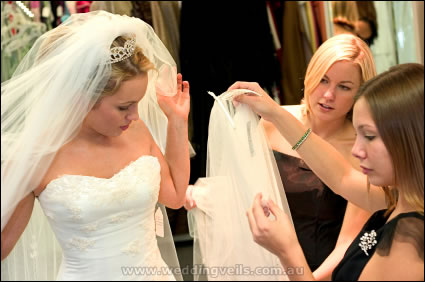How to choose the right veil to suit your dress
So you’ve found the perfect wedding dress, and it’s just divine. Whether you bought it off-the-rack or decided to have it custom made, you now need to decide on which veil to wear with your dress.
There are so many different types of veils to choose from, so how do you know which one will look perfect with your wedding dress? There are several factors to consider when choosing a veil.
Wedding dress silhouette:
The style or silhouette of your wedding dress is the first thing to consider. As a general rule, the slimmer the gown, the longer the veil. For example, a slinky figure-hugging wedding dress with a short train looks fabulous with a long, chapel length veil. The Dynasty Single Tier veil is an excellent veil to wear in this case. Ideally the veil should be longer than the train of the dress so that it trails behind you as you walk down the aisle.
For a mermaid or fit and flare wedding dress, the Allure Chapel Single Tier veil is ideal as it creates a floaty, dreamy look. A waist or fingertip length veil can also work, but would need to be long enough to skim over the key details of the dress, such as our Allure ST veil.
For a full, princess style wedding dress, a fingertip veil such as our Elegance two tier veil works very nicely. However a chapel length veil such as our Allure Chapel two tier veil looks simply glorious with princess dresses.
For an A-line wedding dress, consider a shorter veil such as elbow or waist length. Our Romance ST veil is a lovely choice here.
Your hairstyle:
The way you plan to wear your hair on your wedding day will also affect the style of veil you choose. Generally speaking, your hairstyle should compliment your gown. Some veils are designed to be worn high on the head, thus your hairstyle needs to accommodate this.
For example, with a down hairstyle, you should wear the veil higher on your head so that it doesn’t fall out. It is recommended to have a section of your hair up, so that the veil can be anchored on to it. You need to do this, otherwise the veil has insufficient hair to hold on to and can slip out of your hair.
Alternatively, if you are having an up hairstyle, position the veil at the top of your up-do, or under the up-do, depending on the look you prefer. For more tips, see How to Wear a Veil.
Wedding dress fabrics:
Another factor to consider is your wedding gown fabrics, as this mainly affects your choice of trim or edging for the veil. For example, if your wedding dress is made of silk or satin, then satin edging on the veil compliments the dress nicely, such as our Elegance ST veil. A softer flowy gown made from chiffon or georgette looks better with a fine veil edging, such as a pencil or stitched edge. If your wedding dress has crystal beading, consider having some crystals scattered on your veil, such as the Allure Crystal beaded veil.
The immense popularity of lace wedding dresses has caused some confusion about what style of veil to wear with such dresses. My advice for a full lace wedding dress is to go for a plain, raw edge veil. For example, the Allure Chapel veil as well as Abigail Drop veil are both excellent choices with a lace wedding dress. That way the veil will compliment your dress, without competing with it.
Alternatively, if you prefer a veil with some embellishment or detail, a mantilla veil can look amazing as long as the lace trim matches or compliments the lace on your dress. Another option is to have a lace or beaded veil with a sleek, clean cut wedding dress.
For a vintage style wedding dress, consider a birdcage veil. These veils are made of French netting which create a retro glamour look reminiscent of the 1940’s.
Veil etiquette: To wear or not to wear the veil over your face:
Whether you wear the veil over your face is largely a matter of preference. It is customary to wear a veil over your face for the walk down the aisle, if you are getting married in a church. In this case, a veil with two or more tiers is necessary so that the top tier can act as a blusher. If you are having a garden or beach wedding, or having your wedding in less formal surroundings, then it is not necessary to wear a veil over your face. Most brides choose to wear single tier veils for less formal or garden weddings, where the veil is simply worn towards the back of the head.
Finally, your choice of veil will complete your overall look as a bride. Think about how you want to look on your wedding day and choose wisely. After all, your veil will be featured in all of your wedding photos!

